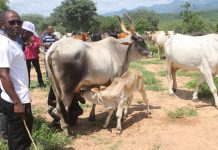Africa-Press – Botswana. A sweeping reimagining of what agriculture means in Botswana – not just as a sector but as a lifeline and a promise – is taking shape. Much progress has been made because the draft is now in the form of 120 policies covering 12 themes that await the input of Batswana before it can be adopted to steer the sector through the next decades.
A dedicated team of agricultural policy thinkers, economists, climate scientists and extension officers at the newly constituted Ministry of Lands and Agriculture have gotten down to work without a missed step in preparing the much-anticipated National Agriculture Policy of Botswana.
The result is a draft of over 120 policies covering 12 themes that will steer the sector through the next decades. There is a buzz of excitement in the air as the process is nearing the stage where a draft policy will go out to stakeholders and the public for comment. That “something new” is a sweeping reimagining of what agriculture means in Botswana, not just as a sector but as a lifeline — and a promise.
A Question of Survival
Botswana’s farms, though romanticised in tourist brochures and childhood stories, have been quietly in distress. Decades of dependence on imported food, erratic rainfall, and the creeping edge of desertification have left many farmers — especially the young and the poor — questioning whether agriculture has any future at all. Out in Letlhakeng, a young farmer will say that she has watched three of her childhood friends leave the village. And she will assuredly add: “There’s no money in farming.”
Because her entire life has been spent wiping sweat from her brow after a morning of tending to her small plot, she would comment: “The soil is tired. The borehole is unreliable. The market is 80km away. You do the maths.” But in the capital, officials and planners were asking a different question: What if we finally took agriculture seriously? What if Botswana could build a farming sector that fed its people, paid its farmers, healed its land — and maybe even exported with pride? So, the policy team started from scratch and kept digging.
A Framework with Twelve Roots
At first, the task seemed impossible: how to weave subsistence maize growers, cattle barons, forest custodians, aquaculture pioneers, potential hemp enthusiasts, and high-tech hydroponics into a single national vision? But slowly, a structure emerged. Not a commandment from above, but a living framework — one grounded in the realities of Botswana’s land and people. Twelve policy themes, they called them. Not as rules but as roots.
Each theme represented a long-overlooked truth that farmers need more than ploughs — they need finance, climate forecasts, market access, and mentorship. That water, forests and livestock don’t exist in silos. That data is as important as rainfall. That resilience is no longer optional but is the price of survival.
Behind every policy proposal was a face: a woman in Molepolole trying to access credit, a youth co-op in Maun growing lettuce in greenhouses, a villager in Gweta struggling to keep the hydroponics system working, a forester in Shakawe battling invasive pests, a herder in Tsabong counting losses after another drought. This wasn’t abstract reform. It was recovery — and a rebirth.
The Spirit of Coordination
But reform on paper is not reform in practice. Botswana’s agriculture has long suffered, not from lack of intent but from fragmentation. Ministries working in parallel. Projects duplicating. Promises unkept. So the architects of the new policy have built in mechanisms not only for ambition, but for coherence. A national food systems framework will map out every programme, every subsidy, every partner — not just to track, but to align.
Even Botswana’s first satellite, BOTSAT-1, will play a role, offering real-time land-use data to guide planting zones and monitor droughts. This is agriculture moving not just with hoes and tractors but with dashboards and algorithms. Tradition and technology, hand in hand.
Climate Shadows and Solar Seeds
Lurking behind it all, of course, is climate change — that unpredictable storm cloud hanging over southern Africa. Botswana has watched its grazing lands thin, its riverbeds dry, its rains come late and leave early. Yet this policy does not sidestep the crisis — it folds it in. From renewable-powered irrigation to climate-smart seed varieties, from protecting native trees to embracing carbon-credit systems, the strategy acknowledges what too many plans still ignore: the future will be hotter, drier and more uncertain. But it can still be abundant — if we prepare.
The Village Returns
Perhaps the most radical thing about the new policy is not its technology or its bureaucracy but its insistence on dignity in making agriculture matter again in the imagination of young Batswana. There is talk of land leases made easier, of capital made accessible, of digital training hubs in rural areas, and of social protection programmes that integrate nutrition, health and farming.
Of village mentorships where elders and youth learn side by side — not in the shadow of failure but in the light of legacy. Farming should no longer feel like exile, or a place to enjoy retirement but as taking the economic leadership back from the diamond-induced comfort zone.
Beyond Simply Food Security
As Botswana’s diamond industry faces natural decline, agriculture must step in to secure our nation’s future. Beyond ensuring food security, agriculture has the potential to drive economic diversification and create sustainable livelihoods across the country. By investing in agribusiness, innovation, and climate-resilient practices, we can unlock new opportunities for growth, particularly in rural areas.
Agriculture is not just about survival — it’s about thriving in the face of change, providing stable jobs, and nurturing the land for generations to come. In this new chapter, agriculture must rise to fill the void left by the retreat of diamonds.
The Acting Minister of Lands and Transport, Edwin Dikoloti, who has been the driving force behind the new agriculture policy, had this to say. “The draft Agricultural Policy is a bold step towards transforming Botswana’s agricultural landscape. This is not just about policy; it’s about people — our farmers, youth, women and communities. By embracing innovation, improving access to markets, and fostering sustainability, we are committed to creating a more resilient, productive, and inclusive agricultural sector. Together, we can build a future where agriculture not only feeds us but also drives our economic growth and empowers every Motswana.”
An Invitation, Not a Verdict
Now, as the draft policy begins its journey into public consultation, the tone is not one of pronouncement but of invitation. Officials are calling for voices from every district — from community halls to cattle posts — to shape the final version. The stakes are high, and the margins for delay are narrow. But there is also optimism — cautious, yes, but real.
Back in Letlhakeng, they will hear about the new direction with a mix of curiosity and hope. They will say, “If they mean it — really mean it — then maybe we will be able to hold on to our farms.” And they may add: “Maybe even our friends will return.” Because in the end, policies don’t grow food. People do. But a good policy can help clear the rocks, share the water, and finally let the seeds of change take root.
Source: Botswana Gazette
For More News And Analysis About Botswana Follow Africa-Press






